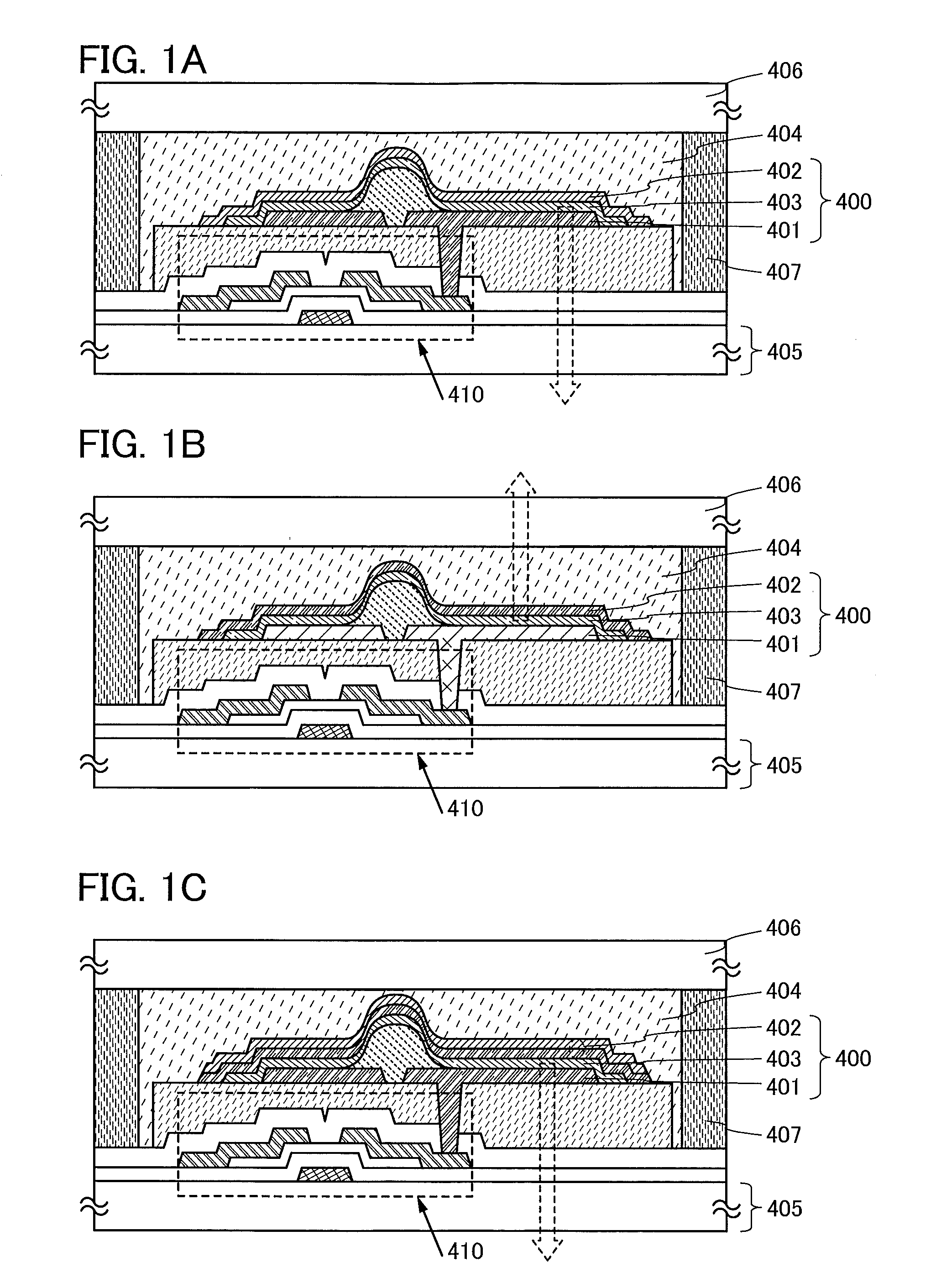Semiconductor device and light-emitting device, and manufactuirng method thereof
a technology of semiconductor devices and light-emitting devices, which is applied in the direction of organic semiconductor devices, solid-state devices, thermoelectric devices, etc., can solve the problems of affecting the reliability of semiconductor devices, difficult to completely remove moisture from semiconductor devices, and/or to completely prevent moisture entry from the air, etc., to achieve high-reliable semiconductor devices and high-reliable light-emitting devices
- Summary
- Abstract
- Description
- Claims
- Application Information
AI Technical Summary
Benefits of technology
Problems solved by technology
Method used
Image
Examples
embodiment 1
[0045]In this embodiment, a structure of a semiconductor device including a semiconductor element using an oxide semiconductor and a light-emitting element in which an organic layer containing a light-emitting substance is provided between a first electrode and a second electrode will be described with reference to FIGS. 1A to 1C. Note that because an inert, electrically conductive material is used for the second electrode of the light-emitting element given as an example in this embodiment, the reduction of an impurity including a hydrogen atom (e.g., moisture) and production of a hydrogen ion or a hydrogen molecule hardly occur.
[0046]The semiconductor device described in this embodiment is a light-emitting device having a transistor and the light-emitting element connected to the transistor. The light-emitting element can also be used for a pixel portion of the light-emitting display device by being provided in matrix arrangement.
[0047]In the semiconductor device given as an examp...
embodiment 2
[0060]In this embodiment, a transistor that has a channel formation region using an oxide semiconductor will be described. The enhancement-type transistor that has a channel formation region using an oxide semiconductor has a gate electrode on one side of a gate insulating film, an oxide semiconductor layer on the other side of the gate insulating film, and a source and drain electrode layers which are in contact with the oxide semiconductor layer and whose end portions are overlapped with the gate electrode. In this embodiment, as an example of the enhancement-type transistor that has a channel formation region using an oxide semiconductor, a structure of an inverted staggered transistor using an oxide semiconductor and a manufacturing method thereof will be described with reference to FIGS. 2A to 2E. Note that the transistor is not limited to an inverted staggered transistor, and the transistor may be a staggered transistor, a coplanar transistor, or an inverted coplanar transisto...
embodiment 3
[0146]In this embodiment, a structure of a light-emitting element applicable to the semiconductor device described in Embodiment 1 and a method for manufacturing the light-emitting element will be described with reference to FIG. 4. Specifically is described a light-emitting element including a first electrode that is electrically connected to a source and drain electrode layers of a transistor that has a channel formation region using an oxide semiconductor and is one of an anode and a cathode, a second electrode that is the other thereof, and an organic layer containing a light-emitting substance between the first electrode and the second electrode.
[0147]FIG. 4 illustrates one example of a structure of a light-emitting element which can be used for a light-emitting device given as an example in this embodiment. In the light-emitting element illustrated in FIG. 4, one of the first and second electrodes is an anode 1101 and the other thereof is a cathode 1102, between which an organ...
PUM
 Login to View More
Login to View More Abstract
Description
Claims
Application Information
 Login to View More
Login to View More - Generate Ideas
- Intellectual Property
- Life Sciences
- Materials
- Tech Scout
- Unparalleled Data Quality
- Higher Quality Content
- 60% Fewer Hallucinations
Browse by: Latest US Patents, China's latest patents, Technical Efficacy Thesaurus, Application Domain, Technology Topic, Popular Technical Reports.
© 2025 PatSnap. All rights reserved.Legal|Privacy policy|Modern Slavery Act Transparency Statement|Sitemap|About US| Contact US: help@patsnap.com



